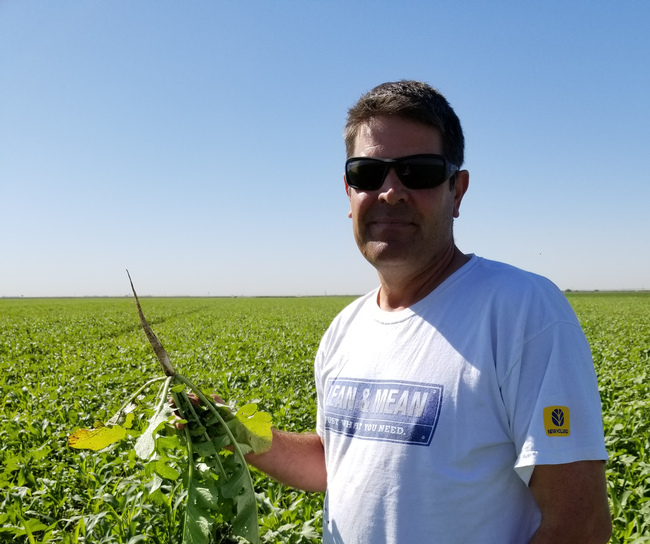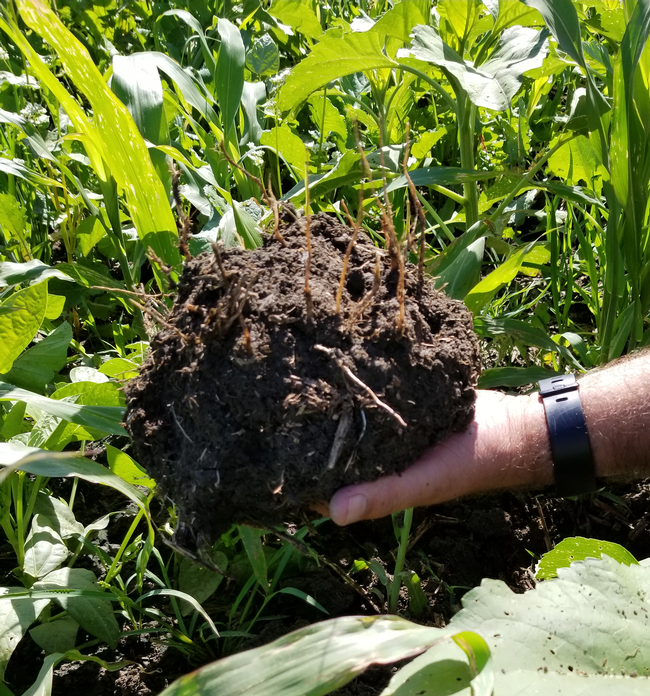Grower Profile #1: Frank Fernandes
Practices: No-Till, Strip-Till, and Cover Crops
Frank Fernandes grew up in a big dairy family in Tulare County. He has continued that tradition and now farms about 1,500 acres near Pixley. He grows corn, wheat, and alfalfa as forage for his cows. He also has a young pistachio orchard.

Transition
Frank and his brothers were among the first in their area to try out no-till 20 years ago. They ran into difficulties and converted to strip tillage 18 years ago. This practice minimizes the number of tillage passes they do. On his strip-till fields, Frank has gone from doing 15 passes per year to only 4 or 5, which saves him fuel and time. He currently implements a hybrid system of strip-till wheat and no-till corn. In 2020, he received a grant award from the California Department of Food and Agriculture's Healthy Soils Program to expand his use of strip tillage.
What initially drove Frank and his brothers to implement strip tillage on their fields was the prospect of reducing their tillage and fertilizer costs. When Frank started going to conferences and meetings about soil health, he learned about the soil health benefits of reducing disturbance and increasing plant diversity.
Four years ago, those discussions inspired him to test out a no-till system on one of his fields and to experiment with cover crops. In this field, he's down to 3 passes per year and 2 crops. He will have to stop planting cover crops in his forage fields to comply with his groundwater agency's implementation of the Sustainable Groundwater Management Act. However, he will continue to plant cover crops in his pistachio orchard, as he believes that the benefits of cover crops there outweigh the extra water costs.

Benefits
Frank has found many benefits in implementing no-till and cover crops on his trial field.
Economics
The first major benefit is his reduction in costs. He has seen a decrease in fuel costs due to fewer tractor passes. He has also begun to reduce his fertilizer usage, since his cover crops provided some of the nutrients needed for his forage crops.
These practices did come with a negative effect on yield for the first couple years of his trial, but he found that the decrease in costs outweighed the drop in yield. The practices still penciled out, even in that first year. The yields have steadily increased over the past 4 years, while the costs have remained low.
Pests
Cover crops are supposed to encourage the proliferation of beneficial insects that reduce pest pressure. Frank has had very little pest pressure this year and has only had to spray insecticide once, but this might be due to this year's weather. He explained that it's hard to see the effects of a cover crop in one field when he's surrounded by growers spraying much more than he does, inadvertently killing off the very beneficial insects he wants to encourage.
Water
In terms of water consumption, he has seen that his no-till field needs more water to get to saturation when he irrigates. However, the field can go for longer periods of time between irrigation events and needs fewer overall irrigation events. He's also seen that the crops suffer less from heat and drought stress than those in neighboring fields. The soil itself is cooler and keeps the plants healthier.
Weeds
He's seen fewer weeds in his no-till field, which has resulted in 1 fewer herbicide application per year compared to his other fields. Weed seeds deep in the soil profile remain buried and cannot germinate. However, he pointed out that cover crops themselves can become weeds, so it is very important to pick the right cover crop for your situation.
Other
One of the intangible benefits that Frank mentioned is that doing these practices has made farming more fun and enabled him to feel good about his stewardship of his land. He feels like he is doing his part to farm in a more sustainable way.
Difficulties
Cover crops
Frank has faced 2 main challenges with his cover crops.
The first is planting the seed correctly. The drill doesn't always put the seed into the soil at the right depth, so the field doesn't get a uniform seed coverage.
The other challenge is, of course, water. He has the choice to irrigate his cover crops and pay for that extra water or depend on the unpredictable winter rains.
No-till
The biggest challenge that Frank has faced with implementing no-till on his field is psychological. Not disking or ripping the field goes against decades of experience. Doing this method was a big leap of faith at the beginning of this trial, when he wasn't yet seeing the benefits. But now, he says that only doing 3 passes per year is no longer a difficulty. It's a major advantage in terms of reduced costs.
Recommendations
Frank would cautiously recommend these practices to other farmers. He explained that not all irrigation systems are set up for the challenges and each farm is different, so each grower's learning curve will be different.
For those starting out, he recommends starting small and slow. That way, the impact of that learning curve on your bottom line will be minimal. Growers can expect to start saving money that first year, despite the lower yields while the soil adapts to the change in management.
Cover crops
For cover crops, Frank recommends planting later in the season when there is more moisture. For instance, planting right before a big storm so that the cover crops can take advantage of the rain.
Strip till
He also found that it's best to work the ground for strip tillage right behind the chopping crew. This leaves the ground moist and produces a nice seed bed. If you wait, you run the risk of the ground getting too hard and breaking your equipment.
Equipment
He has ended up simplifying his equipment needs. He went from a disk to a vertical tillage bar. Instead of buying more and more equipment, he decided to sell off the intensive tillage equipment that he no longer used and use the proceeds to buy the equipment that would enable him to do no-till and strip till.